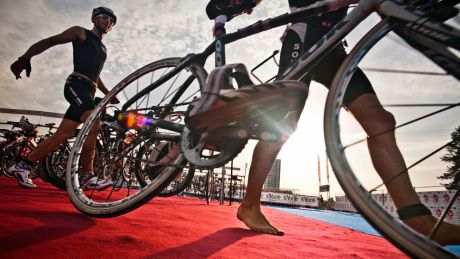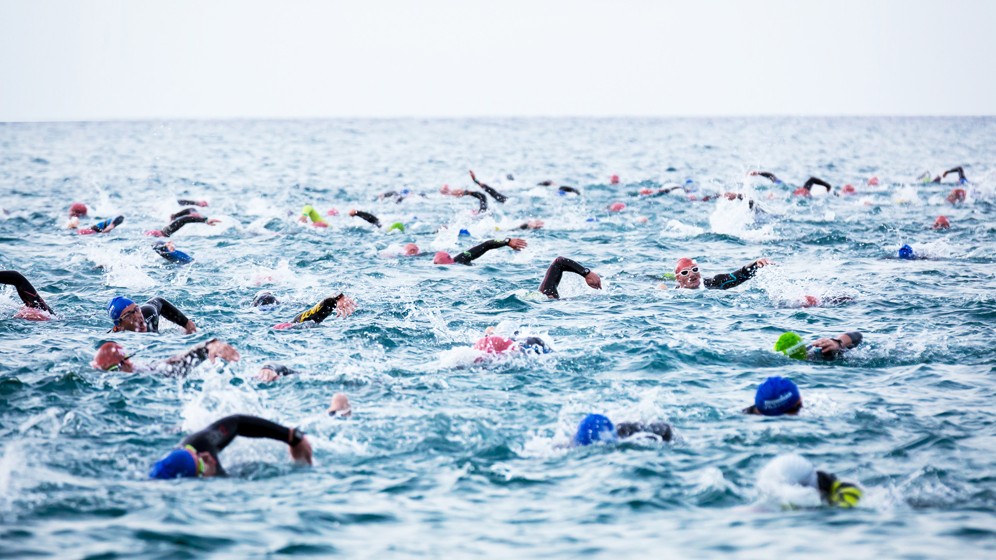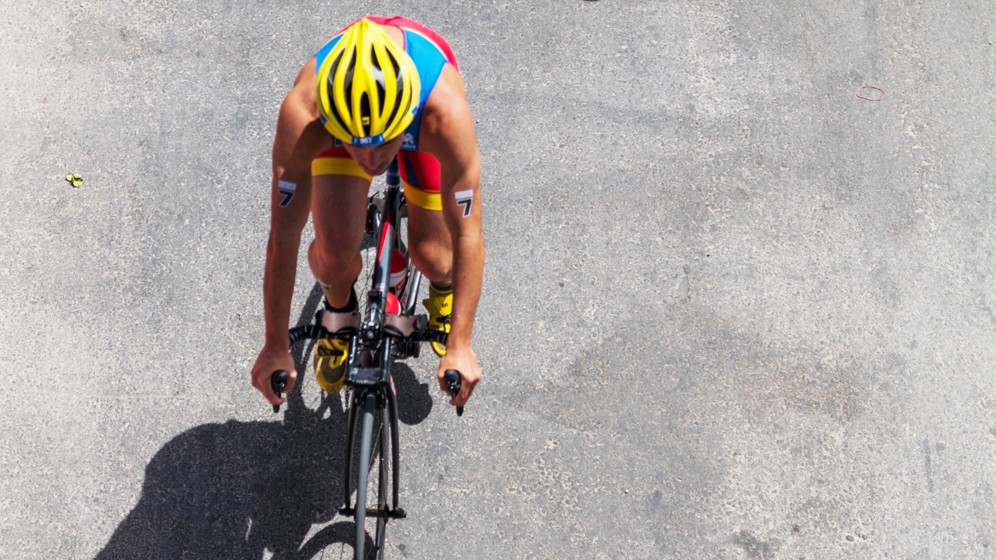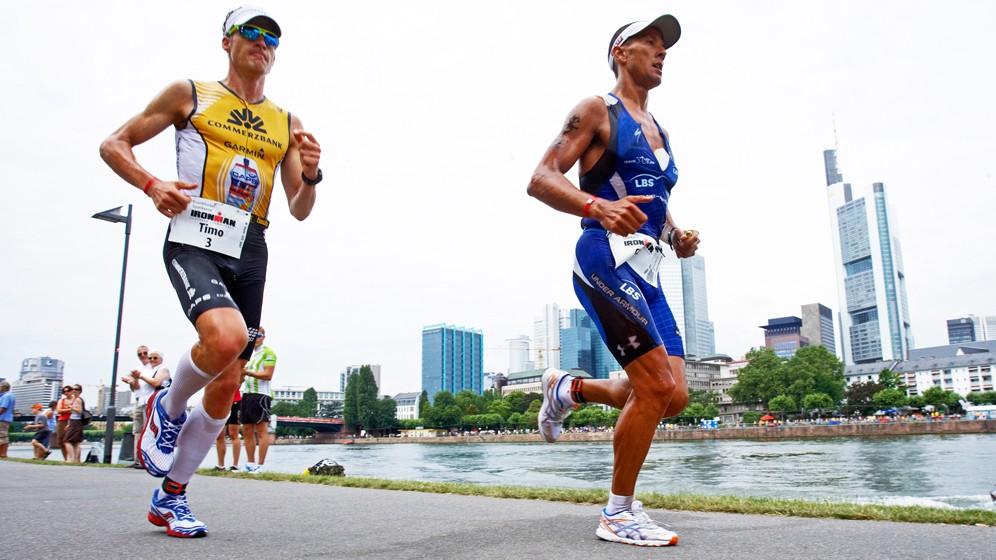Triathlons: The New Fitness Frontier
If you run, cycle and swim then you’re probably ready to try a triathlon. Here’s your guide to the training, kit and race-day tactics

There was a time when taking part in a marathon was an undertaking only for those hardcore and devoted. Now? Chances are if you haven’t done a triathlon, you’ll know at least one person who has.
The combination of swimming, cycling and running was chosen because it is the best test of your overall endurance. Jack Maitland, head coach at Leeds Triathlon Centre, who has helped the UK’s Brownlee brothers secure a cabinet full of world triathlon medals, says, “Triathlon’s sports are ones that pretty much everyone has done at some point,” Maitland says. “So the muscle memory for those sports is already in our bodies, making triathlons uniquely accessible.”
Despite this, many are put off from taking the plunge, possibly because swimming outdoors in a rubber suit seems a bit, you know, odd. But wearing a wetsuit will actually make you more buoyant. Once you’re over that hurdle, then the bike and run seem like a doddle. But before you sign up, there are unique challenges to prepare for. Here’s your cheat sheet.
The Golden Rules of Racing
Survive the Swim

The swim is usually the most intimidating part of any triathlon – fighting through a mob of wetsuits in dark, open water can be a shock to the system. Know these five things
1. Fit your suit. A well-fitting wetsuit reduces your heart rate by an average of 10 per cent in a swim, due to the performance boost the extra buoyancy gives you. If the cost of buying a wetsuit is a barrier, then rent one for your first triathlon. “That will allow you to get an idea of the size and type of suit you prefer before forking out,” says Maitland.
2. A strong start is vital. In most races you don’t want to go off too fast and burn out. But in a triathlon, the most important thing is to get clear water so that you can settle into your own swim rhythm. Sometimes this means expending more energy at the start to get clear of a knot of swimmers and maybe even to draft behind a stronger swimmer. So make sure you are used to fast efforts followed by race-pace swimming.
3. Don’t take things personally. The first thing to realise about a mass start is that you will get bumped. A lot. “There are very few intentional acts of foul play – it’s more often a case of individuals seeking their own clear water,” says James Beckinsale, MSc, Olympic coach and founder of Optima Racing Team. If you get caught between two swimmers you can use a move to get clear. “Drop back slightly and roll over their hips and legs, with your back to their hips to avoid getting kicked in the stomach and winded.”
Get the Coach Newsletter
Sign up for workout ideas, training advice, reviews of the latest gear and more.
4. Sight the buoy. There’s no line on the bottom to follow in open water so you can go off course easily. It’s not unheard of for the whole leading pack of swimmers to go in the wrong direction so don’t just assume that everyone else has got it right. Every three to six strokes look for the buoy to make sure you are on course.
5. Prepare for the bike. “When you are about 100m from the end of the swim increase your kick slightly to get the blood flowing more to your legs from your upper body, which will make the run to your first transition easier,” says Beckinsale.
Boss the Bike

Cycling is – in theory – the easiest part of the event. But it might not feel that way when you get in the saddle after a tough swim. Se here’s how to make good time in the second stage.
1. Drop down. Keeping your body low and riding on the drops of your handlebars [or on tri-bars, a pair of forks that you can clip on], will save you energy because your aerodynamic profile will be smaller. Practise this during your training so you can use it in the race. “You may need to work on stretching out your hamstrings and lower back if you find it awkward,” says Maitland.
2. Breathe right. An efficient cycle is a fast cycle. “The more control you have of your breathing, the more control you have over your heart rate – which means the more efficient you will be,” says Ian Stokell, author of Triathlon. Breathe deeply and rhythmically and avoid taking short, sharp breaths, which fail to exploit your full lung capacity.
3. Save your legs. Maintaining a constant, steady cadence or pedal rpm (90rpm is popular with triathletes – you can practise this on a stationary bike) without pushing a big gear will help to keep your efforts in the aerobic zone, using slow-twitch muscle fibres. This will avoid completely fatiguing the fast-twitch fibres that you will rely on for a fast finish. “Experiment with riding at different cadences in training to see how they make your legs feel in the run,” recommends Beckinsale.
Run for Home

The finish line is so close you can taste it – hopefully that doesn’t mean you’ll end up falling face first at the end. Your legs may feel like they’ve been tasered when you get off the bike and you’ve still got 10km to go. Thankfully help is at hand.
1. Fast feet. Good running technique can save you energy as well as seconds. Research has shown that by increasing running cadence from 170 to 175 steps per minute gains you eight metres per minute. And dropping your pace not only cuts cadence – it uses more energy.
2. Fight the fade. There is a point usually about halfway through the run when it feels really tough. “You need to work hard mentally to get through this ‘no man’s land’ – visualise the times in training when you felt strong,” says Beckinsale. When you start to feel better, don’t be tempted to raise the pace – simply maintain your goal race pace.
3. Finish proud. If you have anything left in the tank, once you can see the finish line – or another triathlete is making a dash for it – lift your knees, put on the afterburners and sprint for the line. Savour the sense of pride that finishing strongly gives you and store it for motivation in your next training regime.
Seamless Transitions

“Make sure you know the mechanics of what you’re going to do in each transition and take into account your equipment – some of it may require modifying – adding elastic laces to your running shoes, for instance,” says Maitland. Another time-saving kit hack is to trim your wetsuit’s wrists and ankles back to make it easier to peel off in a hurry.
T1, as the first transition is called, is often the most crazy. Beckinsale has a tick list for a fast transition: know where your bike is; put your goggles onto your head; peel off your wetsuit, arms first, down to your waist; dump your hat and goggles; put your helmet on as you stamp on your wetsuit to get it off; grab your bike and run to the exit; mount your bike.
T2 is a less crazy transition but your legs may be “jellyfied” as you dismount. Beckinsale recommends taking your feet out of the shoes 400m before the dismount line and pedal over your shoes. Rack your bike and slip on your running shoes, remembering to turn your race number to the front.
Jack Maitland is head coach of Leeds Triathlon Centre, James Beckinsale is author of The Triathlon Training Book (published by DK), Ian Stokell is author of Triathlon (Bloomsbury)
Avoid Chafing
Graham, 31, triathlon coach, on what it’s like to be struck by the chafing curse
I started out as a swimmer, but moved to triathlon later. When I was first starting out, I would get pretty bad chafing around my neck on the swim – I was using a wetsuit that was meant for surfing, rather than swimming, and I paid the consequences. In my naivety, I didn’t even know there were different kinds.
I remember as well starting out and seeing a bunch of older guys slathering on Vaseline or Bodyglide, and I was foolishly confident that I wasn’t going to need it. Then I could barely turn my neck for the chafing, and I felt a bit of a mug.
I was already quite an experienced cyclist, so I knew how important it was to wear proper triathlon shorts and not the bike shorts I was used to. I’ve seen people just get that completely wrong, and the triathlon is such an unforgiving event they definitely lived to regret it.
I resisted the practice of taping my nipples for a long time – it always seemed a little pervy to me, for some reason. Then I got unlucky one run portion, and by the end of the race it looked like I was lactating blood. That was another lesson learned…
The big lesson is that bravado is not the way forward – you’ve got to be sensible and understand that, in particular in endurance events, your body is really fragile. The frustration factor in letting something so simple as chafing get to you is huge – it’s so easily avoided.
RECOMMENDED: How To Prevent And Treat Chafing









